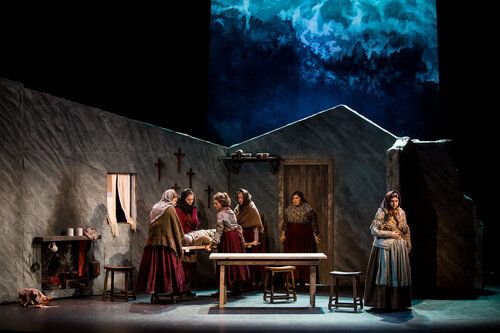Riders to the Sea as a Tragedy
According to Aristotle,
“Tragedy” is an imitation of an action that is serious, complete, and of a certain magnitude… through pity and fear affecting the proper purgation (catharsis) of these emotions.”
Tragedy is a form of poetry or a type of play that deals with a serious topic where emotions of pity and fear are evoked; and venting of these emotions result in a catharsis taking place. Riders to the Sea (1903) is a modern tragedy in one-act which deals with the conflict of the sea and man’s effort to survive; a mother who suffers the pain and agony of losing all her sons and other male members to the sea.
John Millington Synge depicts a fisherman’s family of Celtic origin living in modern times, faraway from the civilized world across the sea. The tragic appeal of the play lies in representing human suffering under the dreadful influence of a colossal force against which man appears helpless.
“They’re all gone now, and there isn’t anything more the sea can do to me.” — Maurya
Fate
The sea takes the role of fate. Fate plays a significant role in Greek tragedies. Synge has attributed the sea with the features of fate. The sea assumes the role of a Pagan God who shows no mercy on the common Aran Islanders. It is their nourisher as well as annihilator. Despite knowing the fact that Maurya will not succeed in overcoming the power of the sea, she puts her efforts into persuading Bartley to prevent him from going to the sea. But where Oedipus and Prometheus strive to conquer fate, Aran men are killed by the sea. He is like a modern Hecuba who has to face the deaths of all her kinfolk. It is rather the nemesis of human life that comes down, rudely and cruelly, to shatter all human hope and happiness.
Peripeteia
Peripeteia, or reversal, comes in the form of Bartley’s corpse, which arrives instead of the anticipated body of Michael. Ironically, poor Bartley wears dead Michael’s clothes and in the tragic dream of Maurya is the one that she recounts to her daughters.
Anagnorisis
The Anagnorisis or recognition comes in the form of Maurya’s serene acceptance of the truth and embracing of greater humanity. There is no death on stage but comes through repeated actions; the women present an acting like a chorus that is meant to be a choice of commentators. The play begins with an impression of death haunting the characters from all corners of the cottage and ends with a tranquil acceptance of the inevitability of human mortality.
Maurya’s unconscious tragic prophecy of her future bereavement while the body of Bartley is to be found and Maurya’s lamenting last words are reminiscent of Greek choruses justifying the ways of gods and moralizing on human suffering.

Dramatic Irony
John Millington Synge has embedded the play with dramatic irony. Bartley’s actions resemble those of Oedipus, where a striking irony lies in the fact that they wish to escape from their fate but the character runs directly into it.
Foreshadowing
Foreshadowing always occupies a special place in Greek tragedy. In Riders to the Sea, the stage direction suggests the misty and ominous presence of death everywhere. The presence of white boards and a rope in the kitchen symbolizes a coffin, grave and death. The dilapidated cottage in front of the choppy clips facing the turbulent sea represents helplessness and submissiveness to a mighty power. In Oedipus the King, in Greek plays “the beginning obstacles”, the tragic hero is warned about his future. In Oedipus the King, we find the oracle at Delphi and Teiresias, the prophet. In Agamemnon, Cassandra was a prophet that no one would believe her. In Riders to the Sea, Maurya prophesies and foretells the coming doom: “He’s gone now, God spare us, and we’ll not see him again… and when the black night is falling I’ll have not a son left me in the world.”
Unities
From the technical standpoint, Riders to the Sea also comes close to the classical tragedy. The three unities of time, place, and action are scrupulously followed by Synge. The play has a single plot, which is the acute suffering of an old mother, who has lost her all to the sea. The duration of the action of the play, the action which is delayed in a lonely sea cottage, does not cover more than an hour.
In Greek tragedies, action is divided into five sections, but Riders to the Sea dialogue takes place to fulfill the role of action. These are: the conversation between the two sisters before the entry of Maurya; dialogue between Maurya and Bartley; the opening of the bundle of clothes in Maurya’s absence; Maurya’s fateful vision and finally Bartley’s death.
Chorus
The play does not have the conventional chorus like that of the classical tragedy. But a conversation of the two sisters, Cathleen and Nora, takes the role of the chorus. The exposition is mainly carried out by the chorus in Greek tragedies. Cathleen and Nora throw light on the desperate situation of the family. They tell the audience and the reader their financial and psychological problems. In a way, they are Antigone and Ismene mourning for their dead brother.


